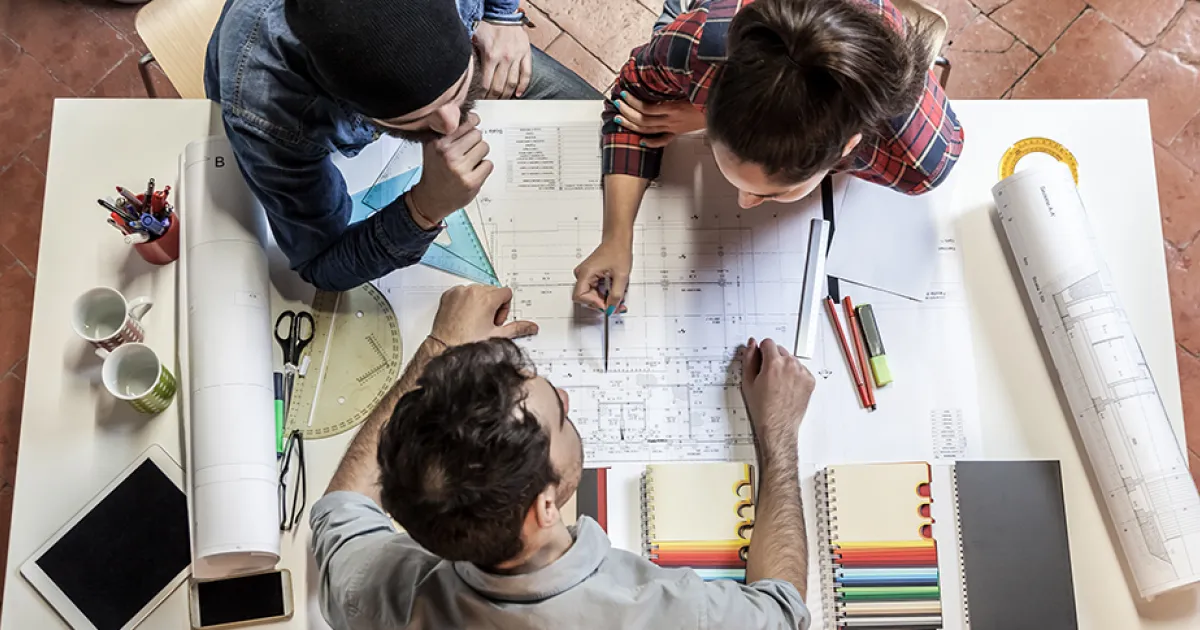Comprehending the Diverse Profession Paths Available for Aspiring Architect
As an aspiring Architect, you have a world of occupation paths awaiting you. Each course supplies special difficulties and possibilities to use your creativity and technical expertise. Whether you're drawn to traditional style or the subtleties of sustainable design, there's a specific niche that lines up with your interests. Understanding these diverse choices can form your professional trip, but which direction will you pick to discover initially?
Standard Style: Creating Buildings and Frameworks
Conventional style concentrates on making structures and structures that mix functionality with visual allure. As you discover this area, you'll appreciate the intricate balance in between type and function. You'll find out to attract inspiration from historical styles, including components like proportion, products, and craftsmanship. Your layouts can show cultural heritage, showcasing regional customs while fulfilling contemporary demands.
You'll create skills in drafting, model-making, and site evaluation, allowing you to visualize and communicate your concepts properly. Engaging with customers, you'll need to comprehend their vision and translate it right into practical designs.
Furthermore, developing codes and sustainability methods are essential in your job, guaranteeing your frameworks are environmentally pleasant and secure. As you grow in your career, you'll discover possibilities in domestic, commercial, or also reconstruction tasks, each offering distinct challenges. Welcoming traditional design leads the method for a fulfilling job that pays homage to the past while shaping the future.
Urban Preparation: Shaping Areas and Public Spaces
As an ambitious Architect, you can play a crucial role as an urban planner, changing exactly how communities work and connect. By using area interaction methods, you'll guarantee that locals have a voice fit their atmosphere. Plus, incorporating sustainable style concepts will certainly help create areas that not only meet today's requirements however additionally secure the future.
Role of Urban Planners
While numerous may think of designers as the sole dreamers behind structures, city coordinators play an important role in forming the wider landscape of communities and public rooms. By teaming up with various stakeholders, you'll help develop parks, transport systems, and household areas that advertise social interaction and accessibility. Your expertise in spatial style and area characteristics allows you to picture future growth while preserving cultural heritage.
Neighborhood Interaction Techniques
Effective community engagement techniques are essential for metropolitan organizers to guarantee that the voices of residents are listened to and valued in the planning process. To foster significant dialogue, you ought to focus on open discussion forums and workshops where community participants can express their concepts and worries. By proactively incorporating and listening comments, you'll develop rooms that reflect the neighborhood's requirements, inevitably leading to more lasting and effective city atmospheres.
Lasting Style Principles
When developing urban rooms, incorporating sustainable design concepts is critical for developing settings that thrive both ecologically and socially. You ought to start by focusing on power performance, making use of materials that lower waste and advertise recycling. Think about integrating environment-friendly rooms, like gardens and parks, to enhance biodiversity and enhance air quality. Promoting walkability and public transportation can minimize dependence on cars, fostering a much healthier area.
Creating with water preservation in mind is likewise vital-- think of rain yards and absorptive surfaces to handle stormwater. Entailing area members during the planning procedure warranties that the spaces you produce meet their needs and motivate social communication. By embracing these concepts, you'll contribute to vivid, lasting metropolitan landscapes that profit everybody.

Landscape Style: Developing Lasting Outside Environments
As you discover landscape design, you'll find crucial style principles that develop useful and attractive exterior rooms. Sustainable practices play an important function in making sure these environments flourish while minimizing environmental impact. Plus, you'll find a variety of profession opportunities that allow you to make an actual difference in just how people interact with nature.
Style Principles in Landscape
Comprehending layout principles in landscape design is crucial for creating lasting outside atmospheres that harmonize with nature. You'll need to consider components like percentage, equilibrium, and range to ensure your styles feel natural and inviting. Including native plants not only improves biodiversity but also decreases water usage, making your landscape resistant. Consider the circulation of space and exactly how people engage with it; pathways and seating locations ought to welcome exploration and relaxation. In addition, take note of seasonal adjustments, creating with products that enhance the surroundings year-round (Architect). By prioritizing sustainability and appearances, you can create exterior spaces that improve the neighborhood and promote health. Embracing these principles will certainly establish a solid foundation for your career in landscape style.
Sustainable Practices Review
Sustainable practices in landscape design not just concentrate on looks however likewise prioritize eco-friendly health and resource preservation. By integrating native plants, you enhance biodiversity and decrease the demand for chemical view it fertilizers and pesticides. Implementing reliable irrigation systems assists preserve water and lessens runoff, securing nearby ecosystems. You can create areas that advertise soil health and wellness, such as practicing and making use of organic materials permaculture principles. Additionally, incorporating eco-friendly infrastructure, like rainfall yards and permeable pavements, help in stormwater management and minimizes urban warm. You contribute to a much healthier earth and supply rooms that cultivate community connection when you produce exterior atmospheres with sustainability in mind. Inevitably, these practices guarantee your layouts profit both individuals and the atmosphere for several years ahead.
Career Opportunities Expedition
With a solid foundation in lasting methods, landscape style offers a selection of career paths that enable you to make a purposeful impact on the environment. Urban planners commonly team up with landscape architects to create environment-friendly spaces in city settings, boosting city livability. If you're passionate about education and learning, think about coming to be a landscape architecture educator, inspiring future generations.
Lasting Style: Concentrating On Eco-Friendly Practices
As you explore your job in architecture, welcoming environment-friendly practices can set you apart in a competitive field. Lasting style concentrates on creating structures that minimize environmental impact while boosting occupant wellness. By integrating renewable products, energy-efficient systems, and sustainable building techniques, you'll add to a greener future.
Begin by getting understanding of eco-friendly accreditations like LEED or BREEAM, which can bolster your credentials. Take into consideration exactly how natural light, ventilation, and thermal effectiveness can enhance design. Collaborate with engineers and environmental specialists to introduce remedies that reduce waste and save resources.
Do not neglect the value of area participation-- appealing local stakeholders can inspire designs that balance with the atmosphere. As customers increasingly prioritize sustainability, your knowledge in environment-friendly techniques will not just attract jobs however likewise accomplish your enthusiasm for responsible design. Embrace this critical aspect of the profession, and see your occupation grow.
Historical Conservation: Safeguarding and Recovering Social Heritage
While you commence on your building journey, take into consideration the important function of historic conservation in maintaining our cultural heritage. This field concentrates on the defense and restoration of significant buildings, websites, and structures that tell the tales of our past. By taking part in historical conservation, you'll aid protect the building legacy that forms community identity.
As a historic conservation Architect, you'll analyze historic importance and analyze the problem of frameworks. You'll work closely with conservationists and chroniclers to guarantee genuine restoration strategies are used. This profession path permits you to mix creative thinking with study, enabling you to make remedies that respect original products and workmanship.
Your work not only contributes to sustainability by recycling existing structures yet additionally moved here promotes a feeling of pride within areas. Welcoming this path will aid you end up being a guardian of history, maintaining the tales and appearances that enrich our lives.
Interior Style: Enhancing Indoor Spaces
Historic conservation and indoor design both share a dedication to improving the built environment, however they concentrate on different aspects. While historic preservation stresses preserving a framework's social and historical worth, interior architecture zeroes in on optimizing indoor spaces for capability and appearances.
As a hopeful Architect, you'll find that indoor style permits you to blend creativity with technological abilities. You'll develop spaces that not just look excellent but likewise promote comfort and performance. This area includes comprehending exactly how light, shade, and products interact within an area, affecting state of mind and functionality.
You'll service numerous jobs, from household homes to commercial workplaces, guaranteeing that each environment meets the requirements site link of its residents. By prioritizing individual experience, you can change insides into practical and motivating spaces, making a significant influence on just how people interact with their surroundings. Accept the chance to boost indoor atmospheres and form the means individuals work and live.
Industrial Design: Combining Capability With Visual Appeals
Commercial design plays a vital function in developing products that seamlessly blend appearances with capability, guaranteeing that what you utilize day-to-day is not only aesthetically attractive however likewise useful. As an ambitious Architect, you could involve on your own in this area, concentrating on developing whatever from furnishings to consumer electronics. Your work involves recognizing user requirements, products, and making processes, permitting you to develop cutting-edge services that improve everyday experiences.
In commercial design, you'll commonly team up with marketing professionals, producers, and engineers, ensuring that your styles are not only beautiful yet also viable. You'll discover to stabilize type and function, focusing on usability without sacrificing style. By sharpening your abilities in laying out, 3D modeling, and prototyping, you'll be well-appointed to bring your ideas to life. This job path supplies a vibrant setting where creative thinking meets usefulness, making it a rewarding choice for designers interested in forming the products of tomorrow.
Frequently Asked Inquiries
What Educational Qualifications Do I Need to Become a Designer?
To come to be a designer, you'll need a specialist level in style, usually a Bachelor's or Master's. In addition, you'll need to finish a teaching fellowship and pass the Architect Registration Assessment to practice legally.
Exist Qualification Needs for Various Building Profession Paths?
Yes, there're accreditation demands for various architectural paths. Architect. You'll require to pass examinations, full internships, and often pursue specialized training, relying on your selected focus, like landscape design, urban style, or historical preservation
What Software Program Abilities Are Essential for Engineers Today?

Just How Can I Gain Practical Experience While Researching Architecture?
You can obtain practical experience by interning at architectural firms, joining layout competitors, volunteering for neighborhood tasks, or collaborating with classmates on real-world tasks. These possibilities enhance your skills and build valuable connections in the industry.
What Task Opportunities Exist Outdoors Conventional Design Firms?
You can discover different job opportunities outside typical design firms, like urban preparation, interior decoration, landscape design, building and construction monitoring, property growth, or also duties in sustainability consulting. Each offers special difficulties and rewards.
Whether you're drawn to standard style or the subtleties of sustainable style, there's a niche that aligns with your passions.When developing city areas, including lasting style concepts is essential for creating atmospheres that grow both ecologically and socially.As you check out landscape design, you'll find vital style principles that create gorgeous and practical exterior spaces.Understanding layout principles in landscape design is essential for producing sustainable outside atmospheres that harmonize with nature.In industrial style, you'll frequently work together with online marketers, designers, and producers, guaranteeing that your designs are not only lovely however likewise possible.